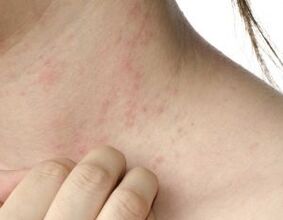
Timely detection of diseases is the key to successful treatment. This rule applies especially to diseases that are difficult to treat. These include lichen scales, which is more called psoriasis. In the past few decades, the disease has covered more and more territories, affecting babies and retirees, and tilting statistics in a depressing direction.
The scaly lichen aroused such serious interest and it was not in vain. Today, psoriasis has shifted from the classification of common skin diseases to systemic pathology. It has been established that patients with this disease are more susceptible to infections, heart disease, depression and diabetes. Due to the lack of a unified treatment system, it is very important to identify psoriasis at the initial stage.
The first signs of psoriasis
Even for people who have never encountered a similar problem, the symptoms of this skin disease can be recognized. A common sign of lichen scales is a variegated rash.
This rash appears on the inflamed area of the epidermis. It can be large or chiseled, with scales, and sometimes purulent fillers. Each individual element of this rash is called a papule. Observations of patients with psoriasis show that even before the appearance of papules, the disease can show the first signs.
In most cases, mood changes, loss of appetite and indigestion occur before the rash. It has been noted that a depressive state usually develops a few days before the first papule forms for no reason. The problem is that patients with similar symptoms cannot see the reason for seeking medical attention. However, even in the case of timely medical treatment, experts are far from always able to determine the real cause of this situation and diagnose correctly.
Skin rash is the main symptom of psoriasis. According to the type of scaly lichen (there are dozens of types), the location of the lesion, the age of the patient, the disease can manifest in different ways.
Children's performance
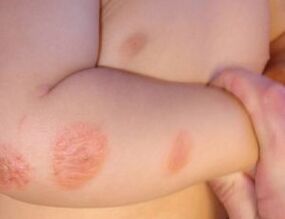
Scaly lichens may even occur in babies. This is very rare, but it is usually exacerbated by the parents themselves. The first signs of this disease may resemble pups or allergies, so adults rely on their knowledge and treat children alone. In most cases, babies with psoriasis will see a doctor when the disease progresses.
In babies, scaly lichens are most often found in folds: on the inner thighs, armpits, between toes and hands, and in the skin folds of the neck. The appearance of pimples is usually accompanied by itching, so the baby may be very upset, staying up at night and refusing to eat.
The lesion is similar to thrush, diaper rash or eczema. The inflamed skin turns red or pink and feels hot to the touch. Pustules can appear as dots or form whole spots-plaques. Usually, these spots will exceed healthy skin. A distinguishing feature of psoriasis plaques is the dry crusty and scales on the rash, but in infants, the papules and plaques are usually located in areas of profuse sweating, which moisturize the inflamed surface.
When these symptoms appear, it is important not to waste time on folk remedies and techniques of the older generation. If the newborn has a rash (of any nature), it is urgent to show it to the pediatrician and dermatologist. The treatment of infant psoriasis is not much different from that of adults. Infants are considered to be therapeutic non-hormonal ointments, and in severe cases, pills and injections are used.
In older children, the initial symptoms of lichen scales are no different from adults. However, children may suffer from any type of psoriasis:
- Plaque-The most common. The signs are dry, red, hot. The papules are covered with crusty skin and have shallow scales on the surface. They can appear anywhere, point to or merge into patches. It itches most often, but not necessarily.
- Pustules-It is characterized by fluid or pus in the papules. The initial stage is the same as the plaque: a papule with sharp edges that rises above the epidermis but is filled with fluid.
- The hairy part of the scalp-It looks like dandruff, but over time, a very flaky crusty will form on the entire head or the entire surface of the head. The hair on the affected area becomes thinner and thinner. This type of psoriasis usually appears in the folds behind the ears.
- The bottom of the palm-It almost never happens in children. The positioning on the palms and soles of the feet is different, and a "lake" with rough skin and scales appears.
- Flexing surface-Most commonly found on the elbows, knees and genitals. In the absence of scales, it is different from other types of psoriasis. The affected skin is covered by a smooth and strong crusty skin that resembles a single spot raised above the surface of a healthy epidermis. Color-light pink, off-white, pink.
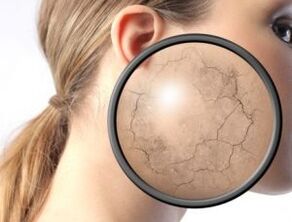
For any signs of local peeling and inflammation on the skin, consult a dermatologist. The progression of psoriasis in children is very rapid, especially when it is accompanied by itching.
Damaged pimples are easily infected, grow and cover a larger area. After following the prescribed treatment plan, it is important to monitor the child frequently to prevent scratches and new injuries to the body, and to diet.
Women's performance
The first stage of psoriasis can be manifested at any age, but the most common outbreak is before the age of 20, although the disease can even "sleep" to 50. Adult men and women experience the same symptoms as adolescents. As we age, the risk of developing psoriasis on the soles, nails, and joints increases.
World disease statistics show that the frequency of women suffering from scaly lichen has increased by almost half and a half, and the main proportion is suffering from plaque psoriasis. It is not clear what causes this selectivity, but scientists believe that there is a hormonal factor in the cause of psoriasis.
Because of the same hormones, the signs of scaly lichens in girls most often appear during PMS, that is, the hormonal background changes. In addition, a woman's natural sensitivity makes her more susceptible to stress, depression and neurosis. For a person prone to psoriasis, any psychological instability will trigger the outbreak of the disease.
Other reasons that make the disease worse include:
- Skin injuries (burns, cuts, open wounds);
- allergic reaction;
- Infectious diseases;
- Metabolism disorder;
- Bad habits and unhealthy eating habits.
In fact, if women are genetically susceptible to psoriasis, then a stimulating factor will sooner or later cause disease outbreaks. To avoid further deterioration, patients must carefully monitor their lifestyle.
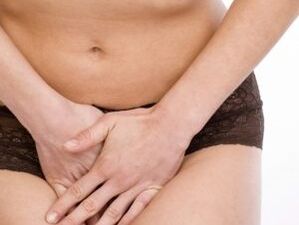
The symptoms of psoriasis in women are the same as those in men, and the only gender difference appears when external reproductive organs are affected. In the genital area, girls face a patchy and reverse appearance, sometimes pustular. The first symptom is inflammation of the skin on the labia or pubic bone, and very few mucous membranes are affected.
There may be multiple or single patches of small needle papules. The scales of genital psoriasis rarely appear because the location does not allow air to enter. A distinctive feature of a psoriasis rash is that the pimples and plaques protrude slightly above the surface and are hot. When such symptoms occur, you should contact a dermatologist and gynecologist immediately.
Male performance
As we have already pointed out, half of men suffer from scaly lichen less frequently than women. However, the course and symptoms of both halves are the same. The investigation and analysis of patients showed that the earliest symptoms of men appeared between 22 and 25 years old, while women began to appear from 15 years old. This "late" symptom is related to the late appearance of the stronger half of the hormone balance.
Psoriasis starts in men in the same way. In most cases, small papules with silver scales appear first and then merge into large spots-plaques and "paraffin lakes".
Laryngeal psoriasis affects most areas of the body at the same time, but separates small joints.
You can also distinguish psoriasis from other skin diseases if you carefully examine the inflammatory components:
- A dense, rough crust is formed on the surface of papules and plaques, and then peeled off. The white scales on the surface are easily peeled off when scraping, similar to shavings.
- If the scales are completely removed from the pimples, a transparent transparent film will remain on them.
- When the film is removed from the psoriasis component, since there are many capillaries in the papules, a large number of blood drops will appear in this area.
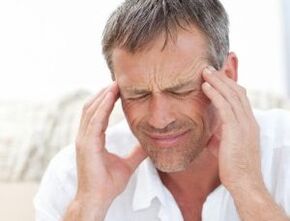
In addition to the obvious symptoms, scaly lichen is sometimes accompanied by general weakness, depression and elevated body temperature. The shape of the psoriasis elements can vary, for example, a small number of single papules appear as punctate lesions. Tear-shaped psoriasis can infect a large area of the body (the entire back, sides, abdomen, and legs) at the same time, while papules are drip-shaped. Larger local plaques are a sign of psoriasis.
Based on observations of patients of both sexes, scientists have concluded that in men, scaly lichens are more serious and the frequency of exacerbations is higher than in women. Expert comments pointed out that this was due to general reluctance to receive treatment. However, the weaker group pays more attention to their health than the stronger sex, and often sees a doctor for prevention. The only type of psoriasis that men do not hesitate is the genitals. Plaque, backward or pustular plaques may appear on the penis, scrotum, or pubic bone of the glans.
In view of the sensitivity of the skin in these areas, inflammation progresses very rapidly and requires immediate treatment. When any rash on the genitals is detected, it is not worth the time to “self-examine” and self-medicate. Even if there is a lot of peeling of the skin, there is no red inflammation and itching, it is considered to be the reason to see the doctor.
Nail (thyroid muscular dystrophy) and scalp psoriasis are also common in men. According to dermatologists, these two types are most common in men. Although there are many pictures on the Internet with signs of this disease, the symptoms of scaly lichens are still considered to be fungus or dandruff, and they have gone to the doctor in a progressive form.
If the scalp is damaged, there will be severe peeling, sometimes itching, and crusty on some parts of the scalp or the entire surface. Nail psoriasis is manifested by changes in nail color, the appearance of depressions and bumps, and the compaction of the nail plate and surrounding skin. We will consider the level of symptoms in more detail below.
Therefore, in children, men and women, the symptoms of psoriasis are no different. Any inflammation on the skin of the body, head or nails is a cause for medical attention. If there is no itching or shedding of the affected area, it does not mean that the skin will not be affected by psoriasis.
Psoriasis symptoms
The initial symptoms of the disease usually last for a few days and then begin to develop rapidly. Sometimes the disease progresses very slowly, and the initial symptoms are "delayed" by a week or more. In any case, this disease will enter a mature stage sooner or later. The location of psoriasis often misleads patients and experts themselves. The psoriasis that initially exhibits the same nails is difficult to distinguish from common fungal infections.
Performance on the scalp
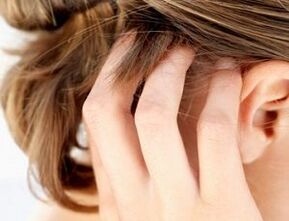
In the early stages of development, the psoriasis on the scalp looks a bit flaking. Gradually, the affected area will turn pale red and may be injured and itchy, sometimes protruding beyond the hairline: behind the head, behind the ears, and forehead. The epidermis in the inflamed area becomes denser, and the dense structure of the psoriasis rash is considered one of its characteristics.
This is often confused with seborrhea, in which the scalp also comes off a lot. However, unlike seborrhea, if the upper scaly layer is removed, the psoriasis component will bleed. In addition, psoriasis is characterized by thickening of the affected skin. If the rash is accompanied by severe itching, the patient will usually aggravate the condition by injuring plaques and pimples. The open wound is quickly infected and the disease progresses.
This scaly lichen appears in children and adults. Attempts to self-medication usually only worsen the condition of the disease, so it is best to consult a specialist when psoriasis is suspected for the first time. Dermatologists and dermatologists can accurately understand the nature of inflammation, and it is best to first see your child to the main therapist.
Body skin performance
On the body, the most common initial pimples appear in folds and rubbing areas: on the knees, armpits, elbows, and neck. Depending on the type of psoriasis, performance may vary. Like children, adults may experience many types of this disease, but some points have been added to the list above.
In addition to the most common scaly lichens, people over 18 may also encounter:
- PustulesThe symptoms are the same in adults and children. It can affect any part of the body and has a serious course. Often accompanied by fever and general weakness. The pimples are first filled with clear liquid, which distinguishes this disease from other diseases. If they are damaged and infected again, pus will appear in them.
- Red skin psoriasis.It is considered a very complex form of this disease, which usually does not appear immediately, but develops from plaques or pustules. However, independent courses can also be conducted. Unlike normal psoriasis, this psoriasis affects most areas of the body and develops quickly. Papules can be "empty" or filled with pus. If the elements of psoriasis damage and grow at a high speed, affecting most areas of the body, it is likely to be erythroderma.
- TearsAs we have discovered, it is characterized by punctate and frequent skin lesions. At the beginning of the disease, the papules are small, with clear edges and teardrop-shaped. At first, it will affect small areas of the body, but it will gradually grow. It may appear on the arms, legs, abdomen, back, and neck.
- Arthritis psoriasis.The worst thing about this disease is the damage to the joints. This usually occurs in people who already have one type of psoriasis, but it can also manifest as a separate disease. At first it affects the small joints: the toes and phalanges of the hands are often moved to more important positions. For him, the first symptoms are joint pain and pain, fever, swelling of the finger bones.
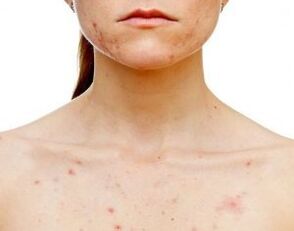
Arthritis and erythroderma psoriasis are considered particularly dangerous because they bring more serious complications. In the event of joint damage, the disease may cause real disability. However, the most common form of the disease usually occurs in patients who already have psoriasis.
Leg performance
The legs are most commonly affected in the knee area, which may be psoriasis or plaque psoriasis. In this case, the knee is completely or partly covered with a dense, white, rough surface. In most cases, the same happens to the elbow due to knee flexion, but not necessarily. We have learned how to identify psoriasis by pimples.
Moreover, the legs are common teardrop-like lesions. In this case, most of the legs are covered by small pimples, which occupy the area from the calf to the thigh at the same time. The elements are inflamed, hot, sometimes itchy and injured.
Thick skin, painful and itchy calluses on the feet indicate plantar psoriasis, and it can "touch" the palm of the hand. This is a very common disease because the feet are most susceptible to mechanical stress. The skin of the lesion is cracked, shedding, and itching. It is important to seek advice in time, because fungi and infections can enter the cracks and cause serious complications.
Performance on nails
Beetle malnutrition affects the nail plate. It is usually accompanied by other more complex forms of psoriasis, but sometimes it appears alone. Patients with this disease usually come late and mistake the disease for fungi. The symptoms of the disease are:
- Change the shape of nails;
- Depressions and nodules on the nail plate;
- Changes in nail color (light brown, muddy, dark spots);
- The skin under and around the nail becomes thicker;
- Excessive growth of the skin on the nails;
- Peel the nail along and along the board.
It is not worth treating this type of disease. It advances slowly and steadily, and as a result, the patient may completely lose his nails without further recovery. For advice in this case, you also need to contact a dermatologist.
Gestures
Psoriasis affects the arms as frequently as other parts of the body. Since he is most susceptible to friction, bending and injuries, his elbow often appears under his "line of sight". In this area, reverse plaque pustular psoriasis is located. In this case, the first signs of the disease develop in the same way as the knee.
A very problematic area on the arm is under the armpit. Any kind of disease will develop very quickly here, because it is a warm and humid place with no air. In this case, psoriasis is not always covered by a flaky shell, and plaques and pustules may resemble normal irritation or diaper rash.
If the inflammation points increase and multiply-you need to consult a dermatologist urgently.
Disease manifestations when joints are damaged
As mentioned earlier, in psoriatic arthritis, the small joints of the fingers and toes are the most common. In a difficult process, this disease can affect the spine and pelvic joints. In the early stages, especially at home, it is difficult to recognize this disease. Unfortunately, diagnosis is very difficult. Today, even clinics can only determine the consequences of joint damage, but cannot prevent the disease.
In most cases, arthropathic psoriasis is a complication of another form of the disease, rarely as an independent disease. A notable feature is that it affects the connective tissue around the joint. For example, if the joints of the fingers are affected, the patient will develop mastitis-inflammation of all tissues in the fingers. At the same time, they increase in size, do not bend, and cause great damage.
Summary
Today, there is no single treatment system for psoriasis, and there is no single medicine that can equally help every patient with this disease. Scaly lichen is classified as a systemic non-communicable disease that occurs in a chronic form. It is impossible to cure it once and for all, but it is possible to achieve long-term relief. The early detection of the disease greatly simplifies the task.
For the sake of prevention, the doctor recommends a routine checkup every six months or a year, even if there is no suspicion of any disease. In the case of skin rash, prolonged irritation, and extensive peeling of the skin, you should contact a specialist immediately and do not waste precious time on dangerous self-medicine treatment.























